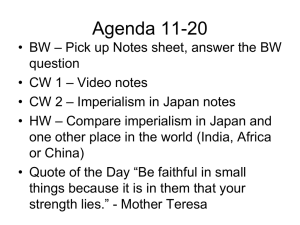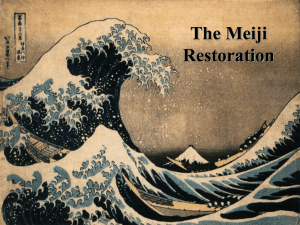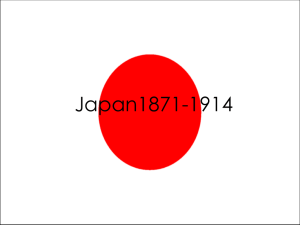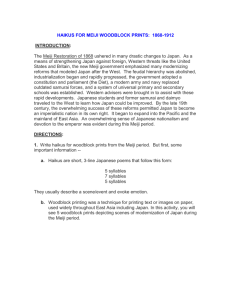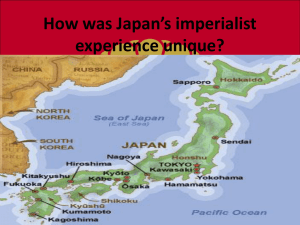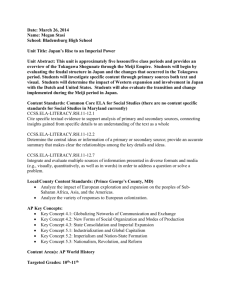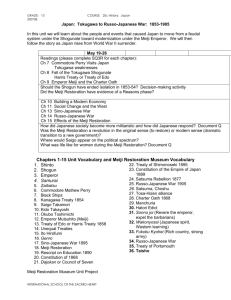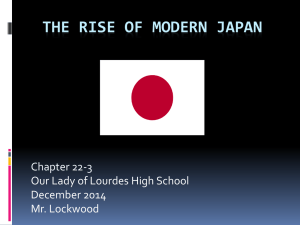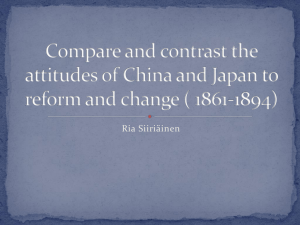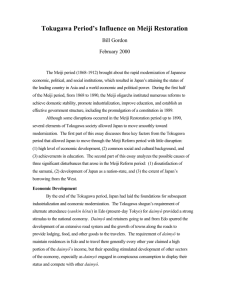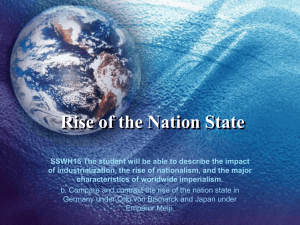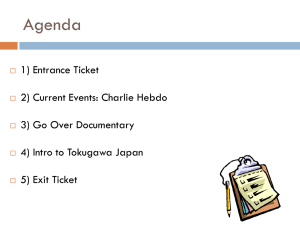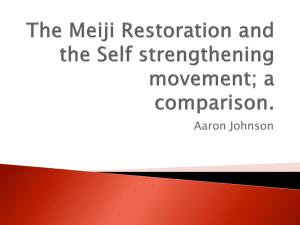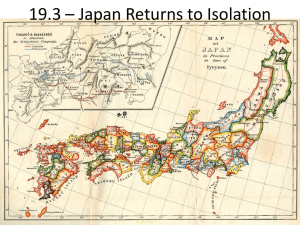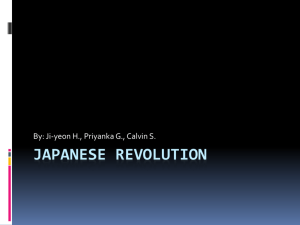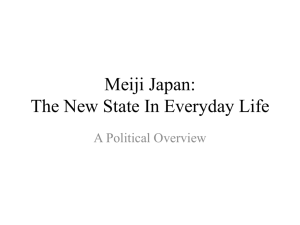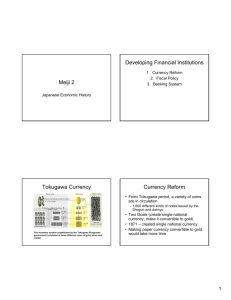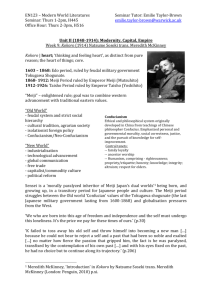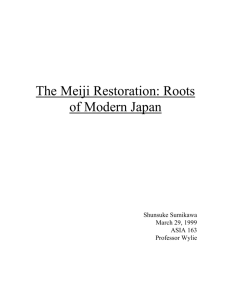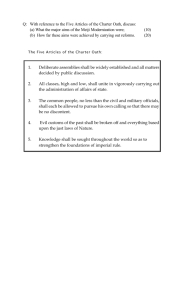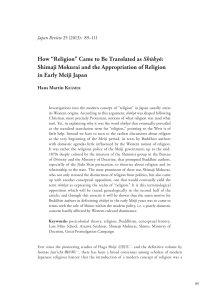The Transformation of Japan
advertisement
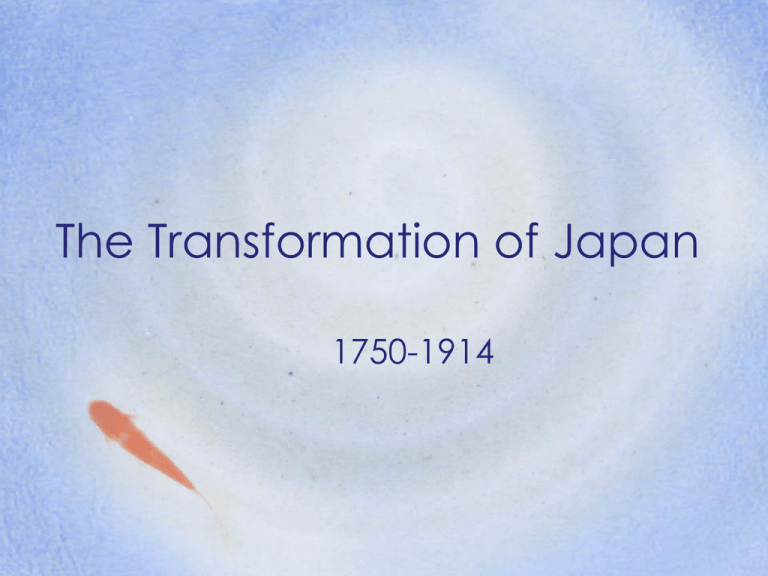
The Transformation of Japan 1750-1914 Map of Daimyos • Here The Tokugawa Shogunate • 1603-1867 • Military governors of Japan • Centralized feudalism • Balanced bureaucracy and samurai From Tokugawa to Meiji • Crisis and reform in early 19th C – Crisis: crop failure, high taxes, rising rice pricesprotests and rebellions – Bakufu tried conservative reforms, resisted • Stressed Japanese culture • Kept abreast of Western science & technology • Some commercial growth, but rural protests – Shortages of funds led to reform movements • Weakened the shogunate • Made Japan vulnerable to external threats From Tokugawa to Meiji • Foreign pressure to end closed door policy – 1844, British, French, US requests for entry rebuffed • They had demanded for open trade – 1853, Commodore Perry shows up in Tokyo Bay – Japan forced to accept unequal treaties w/ US & the West – 1856 western consuls & open ports – Shogunate (bowed to the west) vs. Dimyos (maintain isolation)both appealed to the emperor From Tokugawa to Meiji • The end of Tokugawa rule followed these humiliations – Widespread opposition to shogun rule – Dissidents rally around emperor in Kyoto • “Restoration” of the emperor The Meiji Restoration • Meiji Restoration, 1868 – After brief civil war, armies defeated by dissident militia • Samurai class defeats shogun & restores “imperial” rule – Boy emperor Mutsuhito, or Meiji, regained authority – End of nearly 7 centuries of military rule Meiji Reforms • Welcomed foreign enterprise – Fukuzawa Yukichi studied western constitutions and education – Ito Hirbumi helped build Japanese constitutional government • Abolition of the feudal order – Daimyo and samurai lost status & privilegesgov’t took over payments to the samurai – Districts restructured to break up feudal domains (no more daimyos) – New conscript army ended samurai power • Rebelled in 1877, but lost Meiji Reforms • Revamping the tax system – Converted grain taxes into a fixed monetary tax; more reliable state income – Assessed taxes on potential of arable land • Constitutional government, the “gift” to the people, 1889 – Emperor remained supreme limiting the rights of the people – Less than 5% of adult males could vote – The Diet was an opportunity for debate and dissent Meiji Reforms • Remodeling the economy and infrastructure – Transportation: RR, telegraph, steamships – Education: universal primary & secondary; competitive universities – Industry: privately owned, government controlled arms industry – Zaibatsu: powerful financial cliques – 1894—new nobility class formed; civil service exams issued Meiji Reforms • Costs of economic development born by Japanese people – Land tax costs peasants 40%-50% of crop yield, provided 90% of state revenue – Peasant uprisings crushed – Labor movement crushed; Meiji law treated unions & strikes as criminal • Industrial power in a single generation – Ended unequal treaties in 1899 – Defeated China in 1895 and Russia in 1904 Industrial Revolution in Japan • Military reforms to modernize army • Lack of capital led to industrialization • Ministry of industryeconomic development • Factories to develop new technologies • Introduction of private enterprise • Selling manufactured goods abroad Imperial Japan • Resented the unequal treaties of 1860s, vowed to become imperial power • Early expansion to nearby islands – 1870s, to the north: Hokkaido, Kurile islands – 1879, to the south: Okinawa and Ryuku islands • Bought British warships, built up navy, established military academies – 1876, imposed unequal treaties on Korea at gunpoint – Made plans to invade Japan Imperial Japan • The Sino-Japanese War (1894-95) – Rebellion in Korea: Chinese army sent to restore order, reassert authority – Meiji leaders declared war against China, demolished Chinese fleet – China forced to cede Korea, Taiwan, Pescadores Islands, Liaodong peninsula Imperial Japan • The Russo-Japanese War (1904-05) – Russia also wanted Liaodong peninsula, Korea, Manchuria – Japanese navy destroyed local Russian forces; Baltic fleet sent as reinforcements – Japan is now a major imperial power Imperialism in China and Japan • 1600s-1700s—policy of isolation from West. Foreign powers only allowed in 1 trade city • mid-1800s—after winning Opium War, Britain forced China to sign unequal treaties, opening more ports to trade. Other nations demand trade • 1860s—Britain & France force trade concessions; spheres of influence • 1880s-1890s—Open Door Policy, US trading rights; Boxer Rebellion • Early 1900s—Qing dynasty fell during Nationalist Revolution • 1600s-1700s—policy of isolation from West. Only 1 European trading ship allowed per year • mid-1800s—1853, unequal treaties w/ American warships in Tokyo Bay • 1860s—In 1868, Japan started modernization, imitating Western technology & reorganizing army & navy on Western models • Early 1900s—Japan signed 10-yr treaty of alliance w/ Britain. 1904-1905, won Russo-Japanese War, taking over Manchuria & Korea. Now an imperialistic country. Map with prefectures
